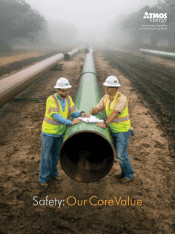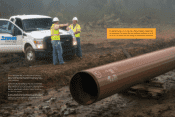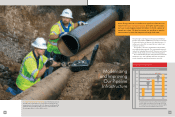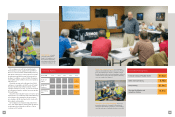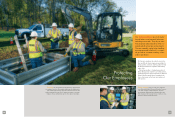Atmos Energy 2015 Annual Report Download - page 10
Download and view the complete annual report
Please find page 10 of the 2015 Atmos Energy annual report below. You can navigate through the pages in the report by either clicking on the pages listed below, or by using the keyword search tool below to find specific information within the annual report.
16 17
To protect our customers and the public, our centralized dispatch
center maintains around-the-clock readiness for emergency calls. We
regularly audit our emergency-call procedures and closely monitor
response times. We constantly strive to improve our performance.
Atmos Energy has been a supporter of stronger safety legislation
and regulations. A showcase example of effective regulation is the
natural-gas pipe testing requirement for all Texas schools. It has virtu-
ally eliminated school gas leaks. Similarly, pipeline damage preven-
tion laws in Virginia and Louisiana have lowered third-party damages
and have helped dissuade careless excavators from working in these
states. We are presently advocating, along with other members of the
American Gas Association, reauthorization by Congress of the federal
Pipeline Safety Act.
Cross-bore Safety Our new cross-bore safety program
warns those most at risk, such as Leon Molinario of
Leon’s Plumbing in Metairie, Louisiana, while the
program seeks to eliminate an unforeseen hazard.
A cross bore is a natural gas or other utility line that
inadvertently was installed through a sewer pipe. If a
clog develops, plumbers and drain-cleaning technicians
usually use a power augur to remove the blockage.
Instead, we encourage them to use a video camera first
to see if a cross bore is present. Here, Joseph Dimm,
a senior service technician in the Louisiana Division,
provides assistance.
We cooperate and coordinate with first responders to safeguard our
communities. In Basehor, Kansas, Bruce Main, a crew leader in our Colorado-Kansas
Division, conducts Natural Gas 101 training for the Fairmount Township Fire Department.
Atmos Energy employees have provided this training for more than 1,700 first responders
in 46 communities. Chiefs and training officers from many fire departments have praised
our program, but those who lead rural or volunteer fire departments have been especially
appreciative because of their limited training resources. In Mississippi, our program has
been adopted as part of the state fire marshal training.
Atmos Energy consistently rates better than industry averages
on all safety measures reported by the American Gas Associ-
ation and by other industry organizations. We also score below
the national averages for employee accidents reported by
the federal Occupational Safety and Health Administration.
We focus on measuring three areas of safety. System safety
includes excavation damages, leaks found, age of open leaks
and unprotected bare-steel pipeline mileage. Employee safety
tracks primarily employee injuries and vehicle collisions.
Public safety looks at emergency response times.
Although we have multiple safety goals to achieve within
each of these three areas, we are more concerned with mea-
suring our overall progress of being incident-free every day,
the top goal we strive for in our culture of safety.
Anthony Tetto, a senior consultant for AEGIS, our primary insurance provider, leads a Loss Control
Review at our Mississippi Division. Drawing upon utility engineering and risk assessment expertise from
throughout North America, AEGIS provides an objective review of our operating procedures and practices
to help us identify potential problem areas and improve public and employee safety. In the assessment
meetings, key operating, engineering and support personnel review safety policies, practices and programs.
How do you know whether your
company is the safest natural gas
distributor in the country?
Measuring Our
Safety Progress
3 Types of Safety Measures
System Safety
Employee Safety
Public Safety

